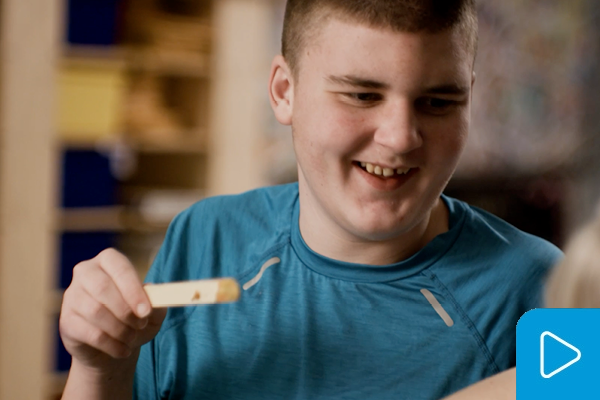4 MIN READ
Supporting A Complex Learner’s Needs
By: Jennifer Daugherty, Chloe Haffley-Saalfeld, Dr. Holli Steiner

When thinking about how best to support a complex learner’s needs, there is a lot to consider! How does the classroom setup look? How is he/she communicating? Are there any interfering behaviors that are restricting access to the curriculum? Is there carryover in the learner’s home and who is responsible for training/ensuring that carryover happens? At Heartspring, we know that it takes a variety of different professionals in their areas of expertise working together in order to make a meaningful impact in a student’s life. The phrase “It takes a village to raise a child” succinctly describes the ways in which a student’s team at Heartspring works together to provide the most effective programming for that child.
In this blog post, we gathered several professionals in order to discuss how to best create an environment for a student that encourages learning. We will look at structure and supports (Jennifer Daugherty, Heartspring teacher), rapport building (Chloe Haffley-Saalfeld, BCBA), and how to expand on communication opportunities (Dr. Holli Steiner, SLP).
Structure and Supports: Let’s look at what this means – structure refers to the physical layout of the room or environment the student is in (think of where the couches/desks are placed) and the supports are the different things provided to the learners within the environment (think of the recipes with pictures in the kitchen). Using both structure and supports assist the learners’ abilities to expand their knowledge, practice routines, and achieve expectations. Here are a few questions to consider:
- What does the current structure look like?
- How can the space be modified to support the concepts/skills being taught to the learner?
- Do spaces need to be more defined in order to help the learner know what to do in that area? For example, should a “finished” bin be placed next to the student’s desk so he/she knows where to put finished work?
- Can visual supports be provided to help the learner? For example, can labels be added to drawers in the kitchen so that the learner knows where the silverware is so he/she can help set the table?
Rapport Building: Building rapport with a student can mean many things, but most simply, it is creating a trusting and positive relationship between the learner and the other stakeholders involved. How does a caregiver, new clinician, or classroom teacher begin the process of building rapport with a learner?
- Engage in activities with the learner that he/she enjoys. If the learner cannot communicate about his/her preferred items or activities, try informal interviews/discussions with the learner’s parents or other caregivers to gain more information. If the parent or guardian is unsure of preferred items or activities, consider completing a reinforcer inventory to help outline specific likes and dislikes.
- Continue to structure the environment and provide supports. We all flourish when we are given clear guidelines and specific instructions, and the process of building rapport is no different. Consider telling the learner or making a visual support to explain who will attend preferred activities with the learner in order to pair that person with that preferred activity. For example, if a learner enjoys going to the zoo, create a visual support that explains who will go to the zoo with him/her, what he/she will see at the zoo, what food options are available at the zoo, and then finally when it will be time to leave the zoo.
- Preference assessments. Preference assessments help determine specific likes and dislikes of the individual learner that can then be utilized as reinforcement for learning. These kinds of assessments look at a preference hierarchy, which orders preferences from what’s the most preferential to the learner to least preferential to the learner. The following link goes into more detail about a variety of preference assessments and their purposes. https://ebip.vkcsites.org/preference-assessments/
Expanding on Communication Opportunities: At the core of creating engaging learning environments, lies the learner’s ability to communicate with staff, parents, and others. Here are some tips and tricks on how to encourage communication opportunities:
- Allow the learner to demonstrate what they already know and their background knowledge. Before beginning a lesson, take a poll with the students and find out what they already know and how they can learn from each other.
- Offer response options that align with the learner’s needs. For non-verbal learners, choice boards might be needed so that they can still be engaged in the conversation about a topic. For a verbal student who might experience anxiety in speaking situations, consider a visual mapping board that can help facilitate discussion (https://www.mindmup.com/) without the added stress of speaking.
- Expand on/extend communication opportunities. For learners who have limited verbal communication, consider language expansion techniques to help them expand on their communication abilities. For example, if the learner says “child cry,” you can extend it and say, “Yes, the child is sad and crying” or if the learner says, “dinner, make,” you can expand on that and say, “Let’s make dinner now.”
Engaging learners can be a complicated task and there are a lot of moving pieces of which to be aware, especially when those learners have complex needs. When in doubt, refer back to the team of professionals that support and surround the learner and solicit their input. Because each professional has a unique viewpoint and focus, the information that is provided could spark a new idea or direction for the learner. Just as it takes a village to raise a child, it takes a village to teach a learner.
More questions or want to chat further? Feel free to reach out!
Jennifer Daugherty: jdaugherty@heartspring.org
Chloe Haffley-Saalfeld: chaffley-saalfeld@heartspring.org
Dr. Holli Steiner: hsteiner@heartspring.org




